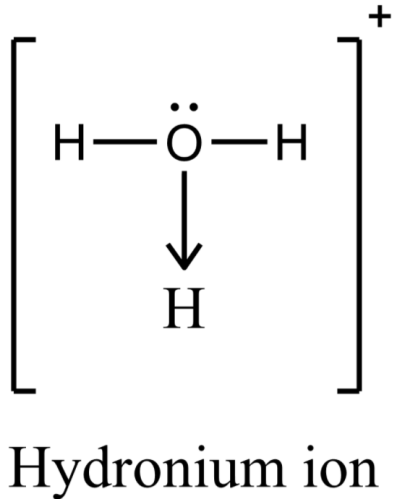
How do you write the electron dot diagram of the hydronium ion
Answer
446.1k+ views
Hint: Electron dot diagrams are called Lewis dot structures. In this representation, electrons are represented using dots. Bonding in a molecule is presented using the atoms along with their bond pairs and lone pairs.
Complete step by step solution:
Hydronium ion is the common aqueous ion. It is produced by protonation of water molecules. Formation of hydronium ions can be explained using the following electron dot diagram.

The central atom in water is oxygen. It contains a total six valence electrons. Two of these electrons form bonds with two hydrogen atoms. There are two lone pairs left on the oxygen atom. A proton is a hydrogen cation which does not have any electrons. When a proton approaches the water molecule, the oxygen donates one lone pair towards this proton and forms hydronium ion as shown below, since both electrons in the formation of hydronium ions are from the oxygen, the bond formed is a coordination bond. The structure of hydronium ion is shown below;

Hence the type of bonding present in hydronium ion is coordination bond. Structure of hydronium ion is trigonal pyramidal with oxygen in
Note: Formula for hydronium ions is
Complete step by step solution:
Hydronium ion is the common aqueous ion. It is produced by protonation of water molecules. Formation of hydronium ions can be explained using the following electron dot diagram.

The central atom in water is oxygen. It contains a total six valence electrons. Two of these electrons form bonds with two hydrogen atoms. There are two lone pairs left on the oxygen atom. A proton is a hydrogen cation which does not have any electrons. When a proton approaches the water molecule, the oxygen donates one lone pair towards this proton and forms hydronium ion as shown below, since both electrons in the formation of hydronium ions are from the oxygen, the bond formed is a coordination bond. The structure of hydronium ion is shown below;

Hence the type of bonding present in hydronium ion is coordination bond. Structure of hydronium ion is trigonal pyramidal with oxygen in
Note: Formula for hydronium ions is
Latest Vedantu courses for you
Grade 10 | MAHARASHTRABOARD | SCHOOL | English
Vedantu 10 Maharashtra Pro Lite (2025-26)
School Full course for MAHARASHTRABOARD students
₹33,300 per year
Recently Updated Pages
Master Class 11 Economics: Engaging Questions & Answers for Success

Master Class 11 Business Studies: Engaging Questions & Answers for Success

Master Class 11 Accountancy: Engaging Questions & Answers for Success

Master Class 11 English: Engaging Questions & Answers for Success

Master Class 11 Computer Science: Engaging Questions & Answers for Success

Master Class 11 Maths: Engaging Questions & Answers for Success

Trending doubts
State and prove Bernoullis theorem class 11 physics CBSE

1 ton equals to A 100 kg B 1000 kg C 10 kg D 10000 class 11 physics CBSE

State the laws of reflection of light

One Metric ton is equal to kg A 10000 B 1000 C 100 class 11 physics CBSE

1 Quintal is equal to a 110 kg b 10 kg c 100kg d 1000 class 11 physics CBSE

Difference Between Prokaryotic Cells and Eukaryotic Cells




